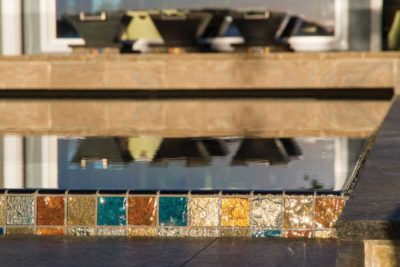The knife-edge

The most challenging aspect during the concrete forming and pouring was creating the ‘Lautner’ knife-edge of the perimeter overflow. This detail originates back to John Lautner, an architect who first used the concept and studied under famed American architect Frank Lloyd Wright.
This detail consists of a pool wall that is sloped away from the water’s edge at a sharp angle (hence the knife-edge), which allows the pool to have no true visible coping. The water overflows the pool wall into a small gap of about 6.35 to 25.4 mm (0.25 to 1 in.) between the decking surface and pool’s edge. The overflowing water is channelled through a perimeter trough or gutter to a holding tank or reservoir, which in turn is recirculated to the pool. The water level achieved is almost flush with the deck surface, giving the pool a unique appearance and highly reflective surface.
This glass-like stillness is achieved since most disturbances within the water are transferred over the pool’s edge as it overflows. The initial application of the concrete during the pouring of the knife-edge is the most critical. The more precision taken during this step would cut numerous hours of preparation time when it came to tiling the edge detail with the selected glass tile. Flamed black-granite stone pavers measuring 609.6 x 914.4 mm (24 to 36 in.) were selected to surround the pool perimeter and cover the overflow trough. Custom steel brackets were required to cantilever and support the granite material. The brackets, resembling a large shelf bracket, were welded on-site to a steel plate that was bolted to the top of the pool trough. The granite stone was cut with a bevel on one side which would sit near flush with the knife-edge leaving a small gap of 12.7 mm (0.5 in.). The stones were adhered to the brackets with a slight slope towards the pool. This would allow any water that may accumulate from wave action or activity in the pool to flow into the perimeter trough.
Full of features
An imported glass tile, manufactured by Lightstreams Glass Tile of California, was selected as the perimeter pool tile, vanishing-edge face, knife-edge tile, step markers and accent tiles for the water and fire features, as well as the covered entertainment area.
This custom blended colour of blue, silver, and bronze tiles are manufactured with an iridescent face which creates a visually stunning array of colours as it reflects light. As the tiles are handcrafted, they commonly suffer from slight imperfections and size irregularities. This proved to be a challenge for the tile setting crews whom placed each tile individually along the vanishing-edge and perimeter-overflow top edge. A combination of rotary laser levels, line lasers, and optical level transits were used to guarantee a precise level of plus/minus 0.79 mm (0.031 in.).
The pool water level itself can sit stationary at perfect level without any means of added recirculation. The concrete pool shell was coated with a water-proofing membrane followed by the glass tile and an application of a thermally applied coating. This coating consists of a colour blend of polymer powder which is pneumatically fed through a nozzle via compressed air, while simultaneously through a heat flame which melts
the powder and adheres to the applied surface.






